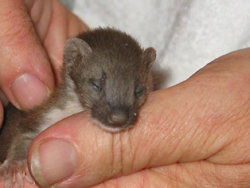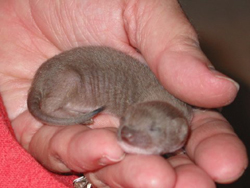|
Mink are born both curious and secretive. They are usually shy but can be very bold when their curiosity has been aroused. They are solitary with the exception of mating season. The American mink shares the common characteristic of all mustelids: anal musk glands that are used for territory marking and defense. As members of the weasel family, their bodies are long and slender with long necks and short legs. Mink range in size from 12 to 17 inches in length. Males are larger than females. Females range in weight from 1 ¼ to 2 pounds. Males range in weight from 1 ½ to 3 pounds. The fur is a rich dark brown to almost black with a white chin patch and throat. Sometimes they have small white spots on their belly. The fur is soft and thick with oily guard hairs that waterproof the coat. A mink’s pelt has a thick under-fur for insulation and buoyancy. The tail is fully furred and slightly bushy. The eyes appear black and are beady in appearance. They have fair eyesight and must rely on their sense of smell to locate prey. A mink’s ears are short, barely extending above its fur. The feet have five toes which are slightly webbed, making mink excellent swimmers. They use all four feet when swimming and are able to dive as deep as 16 feet. They are capable of swimming underwater distances of 50 feet. Mink can reach a top surface swimming speed of 1 to 1 ½ miles per hour. On land, they usually walk or take low bounds covering a distance of between 10-24 inches with each bound. They are capable of running 7-8 miles per hour. They will often rear up on their hind legs to get a better view of their surroundings, and will sometimes climb trees to avoid predators. They will spray a foul smelling liquid when frightened and may squeal, snarl, or hiss. They can make a purring sound when happy and will greet with a bark. Mating takes place between January and March. Females may breed their first year. The average life span is one year but they may live as long as 4 years. Litters of 2-6 are born blind, naked and helpless. Eyes open around 212-25 days. Abandoned burrows dug by muskrat are a favorite place to rest and raise their young. They will also use cavities in brush and rock piles, logjams, and the exposed roots of trees. A den can have several entrances, and includes a nest chamber about 1 foot in diameter. The female usually lines this chamber with grass, leaves, fur or feathers. Mother begins to wean at 5 weeks by bringing home food. Young mink have a surplus of skin at the back of the neck, which protects them from mother’s sharp teeth when she picks them up. By 8 weeks, the weaning process is over and the young mink begin traveling with their mother on hunting trips. Young mink are playful and begin to play fight. They will travel in single file and will mimic mother’s behaviors. They remain with their mother until the end of summer. As fall approaches, the young mink will leave to establish their own territory. The larger males disperse first and the females may not disperse until the following spring. The young mink may establish territory as far away as ten miles. By the age of ten months they are able to mate. Females reach their full growth by the following fall but males continue to grow into their second year. Mink prefer a habitat beside streams and lakes. They are chiefly nocturnal and very secretive. They are rarely seen by humans and are solitary except for family groups of mothers and young. Mink are almost as dependent on access to water as the river otter. The mink will have a narrow territory not more than 150-300 feet from a lake , stream, marsh or river bank. A permanent water source, reliable amount of prey and adequate shoreline vegetation , such as cattails, are important to a mink’s choice of habitat. A male mink travels widely and may occupy as much as 2.5 miles of stream habitat or 2500 acres in wetland habitat. An adult female does not travel as far as the male. Her territory covers about 1 mile of stream habitat and 40 acres of wetland habitat. Males defend their territory against other males. A male may use several different dens within its range. The female usually only has one or two dens and is the only one to use them. Juveniles that have recently left the family group often use several dens until they establish their own territory. There is usually 1 mink for each 50 acres of wetlands and 3-4 mink for each mile of stream habitat, when food is ample. Wild mink are less common than 50 years ago due to habitat loss caused by development, stream channelization and drainage of wetlands. Mink mark their territory and advertise their presence by depositing their droppings and leaving its scent in prominent spots, such as rocks or logs. Mink are active year round, remaining in the den only during severe winter weather. Despite their size, mink are vicious predators. The mink is extremely aggressive and capable of attacking and killing animals much larger than itself. They are seldom if ever interested in plant food. They feed primarily on birds, eggs, frogs, crayfish, and fish. They seldom eat insects or carrion. The males, being larger in size, will also prey on rabbits, large birds, and muskrat. Prey are usually killed and taken to the den to eat. Mink perform a valuable service to man by controlling the small rodent population. It will cache food for later if the prey is larger than it can eat at one time. Mink are preyed on by owls, fox, coyotes, bob cats and domestic dogs and cats. Other reasons for mortality include fighting with other mink, starvation of dispersing juveniles and trapping.
Unlike most other predatory animals, weasels are active both day and night. Evidence suggests that they are better suited to hunting during the day, especially twilight. They are efficient predators and active year round. A weasel’s eyes have a reflective layer of tissue called the tapetum lucidum behind the retina to improve night vision. In the tracks of a weasel, the hind feet and front feet are superimposed . As a result, the tracks look like they were made by two feet instead of four. They have furred foot pads which allow for quickly running over snow. Weasels, like all mustelids, produce a pungent odor called “musk”. When irritated they will discharge their musk as a defense strategy. The long tail weasel has a long, slender body and neck, short legs and a tail, that measures 40-70% of its body length. The upper body fur is brown and the under parts are yellowish white. The long tail weasel has brown feet in summer, where the other members of the weasel family have white feet. The mature long tail weasel has a black tip at the end of the tail. A study was done by a researcher named Roger Powell on the purpose of the black tip. In this study, he trained captive hawks to capture fake weasels. The hawks repeated focused on trying to capture the black tip, with little success. When the fake weasels were replaced with like weasels without the black tip, the hawks were more successful by attacking the body. Powell, concluded that the black tip is a natural diversion to elude predators. Adult males weigh 7 ½ to 12 ounces and females usually weigh 3 ¼ to 7 ½ ounces. Adult males are 12 ½ to 20 inches in length, with a tail length possible of 6 inches. Females are by contrast only 10-16 1/8 inches in length and maximum tail lengths of 5 ½ inches.
The long tail weasel has a home range of 30 to 40 acres. Males have larger ranges than females and do not overlap with other males. Males tend to circulate through their territory, visiting one hunting spot after another. One study found that the male long tail weasels traveled about 230 yards per night in comparison to the female’s 115 yards per night. Dens are usually in a hollow tree or log or some protected place. They will line the den with grass, leaves, fur or feathers. Weasels will occupy a wide variety of habitats including woodlands, brushy areas and borders between woodlands and fields. The density of a population will depend on the season and food availability. Long tail weasels mate in late summer mostly from July through August. They do not give birth until the next April or May. Average litters consist of 6 young, but 9 are possible. The young are born blind and are covered with a fine whitish fur. Their eyes open at 5 weeks. The mother feeds only milk at first but will introduce prey before the eyes open. They mature rapidly and at 3 months of age the females are fully grown. They are mature at the age of one. Due to their secretive nature, very little is known about their social and family life. They are believed to have a wild lifespan of 3 to 5 years. Weasels are preyed upon by snakes, owls, hawks, foxes and occasionally domestic cats.(reprinted with permission from Wild at Heart)
|

 The American Mink (mustela vision) is a member of the family of animals known as mustelids. The mustelid family is known for their feistiness and are often described as fearless. The common name for mink comes from the Swedish word maenk.
The American Mink (mustela vision) is a member of the family of animals known as mustelids. The mustelid family is known for their feistiness and are often described as fearless. The common name for mink comes from the Swedish word maenk. Mink are excellent environmental indicators. Wild mink are subject to a bio-accumulation of dangerous chemicals, such as mercury, because they are at the top of the aquatic food chain. The Illinois Environmental Protection Agency found that the study of mink caught by trappers, was an important addition to water quality tests. The water samples did not always provide a complete picture of how compounds accumulate through the food chain or affect wildlife when they interact with each other in an animal’s body. Through this study, people were warned not to consume fish in certain areas due to the high levels of mercury found in the mink’s system. Mink are also susceptible to Aleutian mink disease virus, a form of the parvovirus.
Mink are excellent environmental indicators. Wild mink are subject to a bio-accumulation of dangerous chemicals, such as mercury, because they are at the top of the aquatic food chain. The Illinois Environmental Protection Agency found that the study of mink caught by trappers, was an important addition to water quality tests. The water samples did not always provide a complete picture of how compounds accumulate through the food chain or affect wildlife when they interact with each other in an animal’s body. Through this study, people were warned not to consume fish in certain areas due to the high levels of mercury found in the mink’s system. Mink are also susceptible to Aleutian mink disease virus, a form of the parvovirus.